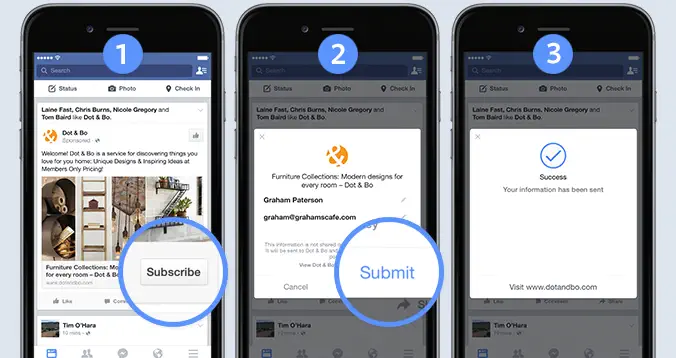
There are so many different ways to generate, purchase, and nurture leads in the digital world. Things can get complicated very quickly; there are so many different tools that you can use to track, verify, and analyze the leads you collect from your site and segment quality based on traffic source, demographic, and other factors. While it is most common to generate leads from an owned and operated website, Walled Gardens such as Facebook have begun to offer in-platform lead generation solutions such as Messenger ads and Facebook lead forms. At Attrakt, we have created campaigns on behalf of our clients using both Messenger ads and Facebook lead forms. Through these campaigns, we have gathered insights into the benefits and drawbacks of collecting leads using these tools.

Benefits:
1. Best possible CPMs and campaign metrics
Because lead forms are native to Facebook’s platform they typically carry favorable economics when compared to conversion ads which link to an advertiser hosted web form. When using Facebook lead ads, we find that CPM’s are up to 40% lower than on ads which link out to an off platform lead form. Furthermore, CTRs and conversion rates are also typically higher when using Facebook lead ads. We believe that the improvement in front end performance seen when utilizing Facebook lead ads is largely due to Facebook’s own preference for keeping user’s in their platform. With lead ads, users fill out the in-platform lead form and remain in the respective Facebook owned app they were using. Therefore, Facebook can afford to charge a lower CPM for access to targeted audiences and may also shift preference in delivery to advertiser’s using Facebook lead ads (thus explaining increase in CVR and CTR).
2. Flexible form fields for in platform A/B testing
Facebook lead ads allow for quick testing of all elements of the acquisition funnel. As with all Facebook ad types, advertisers can test targeting, ad copy, ad images, and delivery optimization features such as CBO and dynamic creatives. Facebook lead ads also allow for the flexibility to test and optimize the lead forms themselves; advertisers can test adding or removing different form fields, different header images in the lead form, and different copy used in and around the form. The ability to test so many different elements of the Facebook lead ads funnel makes it a versatile solution to quickly optimize upon a baseline funnel and test and narrow down variations quickly.
3. Simple setup and tracking
Setting up a Facebook lead ad campaign is a straightforward and hassle free process. You can set up your Facebook lead form in your Business Manager portal and customize what form fields you want to ask consumers to fill out. Furthermore, there is no need to setup pixel tracking because all conversions are tracked automatically since Facebook controls the form itself. Leads generated via Facebook lead ads can be easily imported to your CRM or email using tools such as LeadSync or Zapier.
Drawbacks:
1. Inability to filter leads
Unfortunately, Facebook currently offers no feature allowing advertisers to filter leads which don’t match a certain criteria or that contain clearly bogus information. While business owners often implement various widely known APIs to verify user address, phone number, and email, Facebook lead forms do not support any third party integrations. Advertisers must beware that they will inevitably receive a higher number unqualified or hard to reach leads from their lead ads than they would on hosted web forms.
2. Limited creative and form control
Appearances matter, especially in the lead generation space. Oftentimes a successful lead generation site may test CTA button color, fonts, and many more visual elements of their form. With Facebook lead ads, advertisers are limited to a single default form appearance and structure. Therefore, advertisers in many cases are unable to carry over key learnings in form design and layout to their lead ads campaigns.
3. Legal Limitations
A key consideration for companies with large lead generation programs is compliance. Federal statutes like TCPA require companies to disclose the end points of the information consumers are submitting. Oftentimes, certain consumers opportunistically try to catch companies off guard, nitpicking a minor TCPA violation in order to settle with the company for a substantial sum. With Facebook lead forms advertisers can add a disclosure and privacy policy before user’s submit their information. However, Facebook’s default disclosure settings often do not provide advertiser’s with adequate compliance protection. Tools like ActiveProspect verify a user’s journey in converting to a lead and allow advertisers to operate with confidence that their users have truly opted in to receive a call from them. ActiveProspect does have an integration with Facebook starting at $250/month. Depending on the size and complexity of your lead generation business, you may want to consult an attorney to verify whether or not your advertising activity on Facebook lead ads complies with TCPA and other related Federal laws & statutes.
In summary, Facebook lead ads is a convenient and simple way to collect leads. For new business owners looking for an easy way to find new prospects that doesn’t involve building out and managing a hosted web form, lead ads offer an easy way to start lead generation campaigns at a low cost. However, for businesses who are growing and have a need for lead quality filters and rigorous compliance measures, Facebook lead ads likely do not offer sufficient flexibility.
If you have additional questions about Facebook Lead Ads and how this placement type can be useful in your business feel free to get in touch with us.